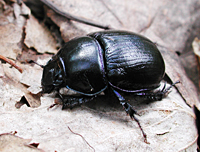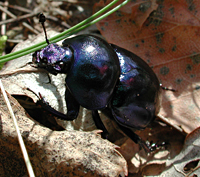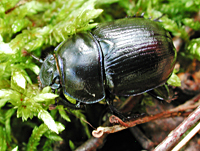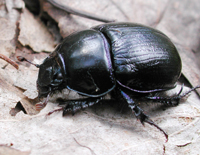[All pictures of garden wildlife on this page are thumbnails. Click on any thumbnail for a large format to be displayed.]

Dor beetle / Geotrupes stercorarius
| Taxonomy | ||||||
|---|---|---|---|---|---|---|
| Kingdom: | Phylum: | Class: | Order: | Family: | Genus: | Species: |
| Animalia | Arthropoda | Insecta | Coleoptera | Geotrupidae | Geotrupes | G. stercorarius |
Geotrupes stercorarius is a classic representative of the family Geotrupidae. Its Greek name derives from the words 'geos' meaning earth, and 'trypetes' meaning borer. In English these insects are therefore called 'Earth-boring Dung Beetles'. Another common name is 'Dor Beetles'. When flying, Dor Beetle can already be heard from the distance of a couple of meters. It produces a low buzz sound, similar to drone, ('dor' is an ancient form of the word 'drone'). Geotrupes stercorarius is between 14mm and 25mm in length with metallic shiny black or bluish or greenish coloration of the body. The beetle is fairly common all over Europe, including the UK. These beetles can be found from April to October.
Adult and larvae of Geotrupes stercorarius feed on droppings of animals. In springtime both male and female beetles dig a hole in the ground which can be up to 50cm long. Using their hind legs the male and female roll balls of dung, decaying fungi and rotting plants to the bottom of the burrow. On top of it the the female lays eggs and then the burrow is carefully sealed off. After hatching the larvae will stay about a year underground and feed on this stored food. It is a greedy creature with a tremendous appetite as it can gobble the amount of food equal to its size every day.
By moving huge amounts of dung and waste material and by digging in the ground Geotrupes stercorarius plays an important role in fertilisation and structure improvement of soil.

© Copyright 1998-2024 gardensafari.net (Hania Berdys)

 English / engels
English / engels  Dutch / nederlands
Dutch / nederlands




